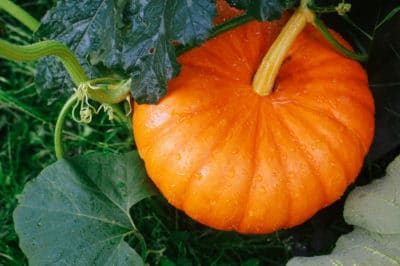Plan Ahead
Every garden requires planning, and growing pumpkins is no exception. Because there is little risk of late killing frost in Texas, the trick is to decide when to plant the pumpkins. If you want the traditional Jack O’Lantern pumpkins to carve for Halloween, the planting time may be different than that of a separate kind like a small decorative of massive Giant pumpkin.
Calculate When to Plant
If your target date for harvest is the end of October, you need to count backward from that time to decide when to plant. Since most pumpkins require approximately 80-125 days of growing time, you should plant your pumpkins in early to mid-July.
Tip: Each packet of pumpkin seeds will show both variety and the average days to harvest.
How to Plant Pumpkin Seeds in Texas
Planting pumpkin seeds in Texas is no different than planting them anywhere else. The only difference is that pumpkins can always be planted directly into the ground in most parts of the state, whereas in colder areas the seeds may need to be started indoors.
Although pumpkins are very easy to plant and grow, there are some things of which you need to be aware:
- Pumpkins proliferate. Provide ample room for their vines to spread.
- Pumpkins require a lot of sunlight. Plant in a sunny location that gets a minimum of 6 hours of sunlight a day.
- Pumpkins require at least an inch (2.5 cm) of water per week.
Caring for Pumpkins
Once the pumpkin seeds have sprouted, it is vital that you provide nutrition in the form of fertilizer and water. Since part of Texas often suffer from drought conditions in the heat of summer, making sure the plants do not suffer is essential.
Since pumpkin leaves are huge, they can provide some help with shading and can help keep the ground moist. However, the leaves alone are not enough to protect the vines from severe heat and dry conditions.
Applying a dense layer of mulch in the form of organic materials will help the soil retain its moisture. Doing so also helps prevent an overgrowth of weeds, which you will appreciate.
Tip: Cardboard and newpapers both work well as mulch.
Diseases and Pests
Two common pests that plague pumpkin vines are the vine borer and the pumpkin beetle. You can prevent both of these by spraying the plant with an organic insecticidal soap or a citrus oil. Alternatively, you can prevent the spread of the bugs by picking them off each plant individually.
Powdery mold and downy mildew are common diseases on pumpkin plants. You can prevent both by watering the roots of the plants instead of the leaves, and by applying an organic fungicidal soap. With care and attention, you can easily avoid any disease or insect infestation.
Harvesting Pumpkins
Since gardeners plant pumpkins for the glorious harvest, there is little as satisfying as watching the fruits turn orange. When the entire fruit is of uniform color, and the vines have started to die off, you can enjoy the fruits of your labor.
With proper planning, growing pumpkins in Texas is an easy project that you will enjoy regardless of your skill level.
